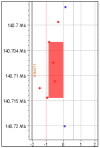A Novel Frameshift Variant and a Partial EHMT1 Microdeletion in Kleefstra Syndrome 1 Patients Resulting in Variable Phenotypic Severity and Literature Review
- PMID: 40428343
- PMCID: PMC12110755
- DOI: 10.3390/genes16050521
A Novel Frameshift Variant and a Partial EHMT1 Microdeletion in Kleefstra Syndrome 1 Patients Resulting in Variable Phenotypic Severity and Literature Review
Abstract
Background: Kleefstra syndrome 1(KLEFS1, OMIM#610253) is a rare neurodevelopmental disorder (NDD) instigated by heterozygous variants or microdeletions occurring in the 9q34.4 genomic region of the euchromatic histone methyltransferase-1 (EHMT1) gene and is inherited in an autosomal dominant (AD) manner. The clinical phenotype of KLEFS1 includes moderate to severe intellectual disability (ID), hypotonia, and distinctive facial features and additionally involves other organ systems (heart, renal, genitourinary, sensory) albeit with phenotypic heterogeneity between patients. The purpose of this study is to expand the genotypic spectrum of KLEFS1 and compare phenotypic features of the syndrome of already published cases.
Methods: Exome sequencing (ES), chromosomal microarray analysis (CMA), as well as sanger sequencing, for confirmation of the de novo status of the frameshift variant, were used.
Results: Here we describe two more cases, both males with a similar age and carriers of novel variants; one with a frameshift variant involving exon 13: p.Val692Glyfs*64 and the other with the smallest so far described, 11 Kb (exons 19-25), 9q34.4 microdeletion: 9q34.3 (140703393-140714454). Both presented with an NDD disorder with one showing more severe ID with significant social disabilities, while the other with the microdeletion had mild ID and following a normal education curriculum. Neither of them were obese nor had any other significant organ system disorder.
Conclusions: The observed phenotypic variability due to genotypic differences in the two children contributes to the expanding spectrum of KLEFS1 disease phenotypes.
Keywords: Kleefstra 1 syndrome (KLEFS1); array comparative genomic hybridization (aCGH); exome sequencing (ES); microdeletion 9q34.4.
Conflict of interest statement
Authors Maria Tzetis and Aspasia Tsezou were employed by the company GeneTech Analytics Ltd. The remaining authors declare that the research was conducted in the absence of any commercial or financial relationships that could be construed as a potential conflict of interest.
Figures
Similar articles
-
Clinical characteristics and genetic analysis of four pediatric patients with Kleefstra syndrome.BMC Med Genomics. 2024 Dec 18;17(1):290. doi: 10.1186/s12920-024-02065-5. BMC Med Genomics. 2024. PMID: 39696517 Free PMC article.
-
Comprehensive EHMT1 variants analysis broadens genotype-phenotype associations and molecular mechanisms in Kleefstra syndrome.Am J Hum Genet. 2024 Aug 8;111(8):1605-1625. doi: 10.1016/j.ajhg.2024.06.008. Epub 2024 Jul 15. Am J Hum Genet. 2024. PMID: 39013458 Free PMC article.
-
Clinical phenotypes and molecular findings in ten Chinese patients with Kleefstra Syndrome Type 1 due to EHMT1 defects.Eur J Med Genet. 2021 Sep;64(9):104289. doi: 10.1016/j.ejmg.2021.104289. Epub 2021 Jul 12. Eur J Med Genet. 2021. PMID: 34265435
-
Highlighting cardiovascular manifestations of kleefstra syndrome: literature review and clinical insights.BMC Cardiovasc Disord. 2025 Mar 12;25(1):175. doi: 10.1186/s12872-025-04610-1. BMC Cardiovasc Disord. 2025. PMID: 40075254 Free PMC article.
-
New Insights into Kleefstra Syndrome: Report of Two Novel Cases with Previously Unreported Features and Literature Review.Cytogenet Genome Res. 2018;156(3):127-133. doi: 10.1159/000494532. Epub 2018 Nov 17. Cytogenet Genome Res. 2018. PMID: 30448833 Review.
References
-
- Rots D., Bouman A., Yamada A., Levy M., Dingemans A.J.M., de Vries B.B.A., Ruiterkamp-Versteeg M., de Leeuw N., Ockeloen C.W., Pfundt R., et al. Comprehensive EHMT1 Variants Analysis Broadens Genotype-Phenotype Associations and Molecular Mechanisms in Kleefstra Syndrome. Am. J. Hum. Genet. 2024;111:1605–1625. doi: 10.1016/j.ajhg.2024.06.008. - DOI - PMC - PubMed
-
- Da Cás E., Pires L.V.L., Linnenkamp B.D.W., Allegro M.C., Honjo R.S., Bertola D.R., Aoi H., Matsumoto N., Kim C.A. The First Brazilian Clinical Report of Kleefstra Syndrome, Including Semicircular Canals Agenesis as a Possible Phenotype Expansion. Eur. J. Med. Genet. 2024;71:104966. doi: 10.1016/j.ejmg.2024.104966. - DOI - PubMed
Publication types
MeSH terms
Substances
Supplementary concepts
LinkOut - more resources
Full Text Sources
Medical



